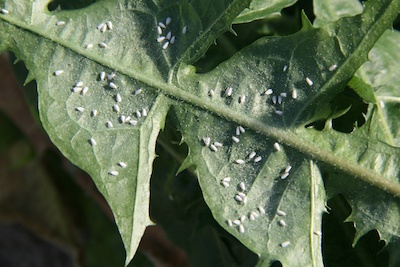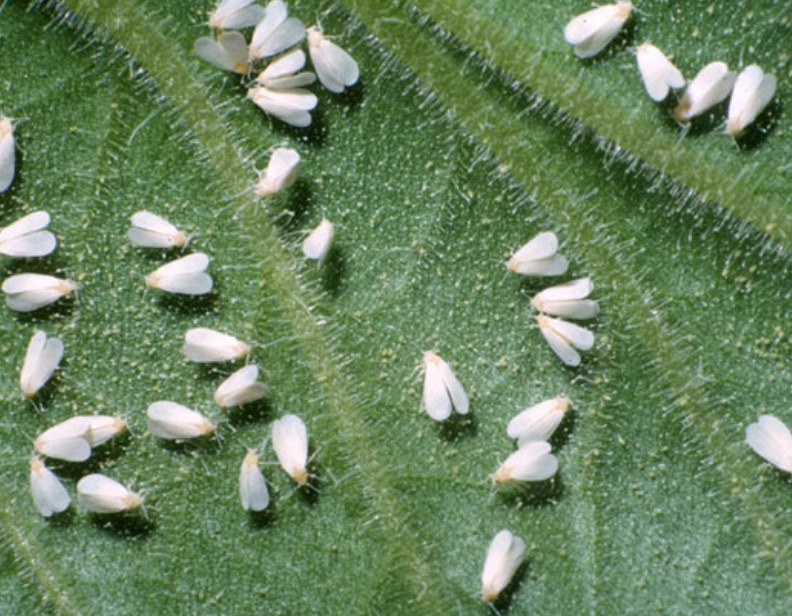Whiteflies, Who Knew?
By Carolyn Casey, Fairfax Master Gardener
Have you noticed black sooty looking stuff on the leaves of your houseplants or the leaves in your vegetable garden and wondered what could be causing this unsightly mess? Or perhaps you have noticed very small bugs fly off your plant when watering or picking it up. The culprit may be whiteflies since they are easily disturbed.

Whiteflies hiding on the underside of the leaf
Whiteflies are easily recognized pests that are found on houseplants. They are not flies but resemble tiny moths that are 2 mm or 0.08 inch long. They are in the Hemiptera order which means they are related to aphids, scale, mealybugs, hoppers and cicadas. When immature they may be mistaken for scale or mealybugs. It is easier to identify whitefly species when they are in their pupae stage since they have specific shapes, color patterns and wax filament arrangements.
There are different species of whiteflies that vary in color from almost transparent yellow or whitish to black with a white fringe. Did you know that their name comes from the mealy white wax covering on the adult’s wings and body?
Whiteflies in the Greenhouse
Whitefly infestations are more serious in greenhouse environments. Most whitefly species in the garden are not major pests and are controlled by beneficial insects. Whiteflies that infest greenhouse plants may become pests in the landscape when infested greenhouse grown plants are planted outdoors. Check your plants for whiteflies before planting them in your yard and check your plants again before bringing them back indoors for winter. Plants that are prone to whitefly infestations are gerbera daisy, poinsettia, lantana, fuchsia, geraniums and bells of Ireland.
Greenhouse Whitefly (Trialeurodes vaporariorum) adults keep their wings flat and over their abdomens. Their pupae are opaque white, oval with elevated vertical sides and long waxy threads rising from the top. Greenhouse whiteflies infest greenhouse plants and have also been known to attack ash, dogwood, sycamore, sweetgum, honey locust, black locust and redbud trees.

Closeup of silverleaf whiteflies
The Silverleaf Whiteflies (Bemisia tabaci) are also known as sweet potato whiteflies. The adults keep their wings tented over their yellow bodies. Their pupae are yellow with two red eyespots and are flatter against leaf surfaces than the greenhouse whitefly. Their abdomens are more tapered than their heads and have several setae. Also, the waxy filaments on them are less noticeable than those on greenhouse whiteflies.
Adult Banded-winged Whiteflies (Trialeurodes abutilonea) have darker markings on their heads and thoraxes and hold their wings like a roof over their bodies. Their wings have two or three grayish-brown lines that zigzag across their width. Their pupae are oval with raised vertical sides and a light brown medial area. Pupae also have a dense marginal fringe of wax that are two different lengths and long hooked wax filaments that rise from their tops. Their preferred hosts are hibiscus, petunia, geranium and poinsettia.

Whitefly damage on bean leaf
Whitefly Damage
Whiteflies are on the underside of leaves where they use their sucking mouthparts to extract fluids from plants. Damage appears as discolored, stunted plant growth and premature leaf drop. Liquid and sugar are excreted as shiny, sticky honeydew that may make the plant look as if black sooty mold is on the leaves. The honeydew attracts ants and they keep away the natural enemies of the whitefly. Also, the accumulation of honeydew can reduce photosynthesis. Large populations of the whitefly can lead to a plant’s death if measures are not taken to control them. Adult whiteflies can spread viruses and disease that may damage or kill plants.
The silverleaf whitefly can also cause specific damage to garden vegetables such as silvering leaves on squash, irregular ripening on tomato, white stalk on broccoli and cauliflower and light root on carrots. Therefore, whitefly infestations may result in severe losses in vegetable crops.
Whitefly Control
It can be difficult to get rid of whiteflies so prevention is key. It is necessary to control whitefly populations and stop plant damage. It is also important to treat when whitefly numbers are small.
Always examine plants before you purchase them. Remove older leaves on heavily infested plants when whiteflies are in the nymph and pupae stages. Vacuum up adults in the morning and place the bag with the insects inside another bag and put it in the freezer for 24 hours. It is good to do this at the beginning of an infestation.
Whiteflies are attracted to yellow so one way to monitor for them in greenhouses is to install yellow sticky traps with Tanglefoot or TACK TRAP on the surface to catch flying adults. Put the sticky traps near doors and vents to monitor incoming adult whiteflies from the outdoors. It is important to use these traps in the fall when temperatures start to cool. The use of yellow sticky traps in vegetable gardens won’t eliminate the whiteflies but can help to reduce their populations. Place the traps so they face the plants, at the level where the whitefly infestation is occurring and away from the sun.
When using chemical controls to suppress the whitefly, you need to completely cover the plant especially the underside of leaves where whiteflies feed. It is important to treat every three weeks until the infestation is controlled. The eggs and pupae are not as affected by insecticides. Recommended pesticides are Bifenthrin, Imidacloprid, Permethrin, Malathion, Carbaryl, Esfenvalerate, Neem oil, Insecticidal soaps, Pyrethrins and soybean oil.
There are systemic insecticides that can be put in the soil and the plants will absorb them through the root system. The systemic insecticide imidacloprid may have a negative impact on the natural enemies of the whitefly, honeybees and other pollinators in your garden when applied to plants that are flowering or will soon flower. It can also cause an outbreak of spider mites. Always follow the label directions. Use insecticides made for greenhouse plants or for use in your vegetable garden and carefully follow all the label directions.
It is better to use systemic insecticides in environments with dense whitefly populations. Whiteflies can develop a resistance when using only one type of insecticide. Properly applied horticultural oil will smother the whitefly eggs and immature stages of the whitefly. Insecticidal soaps are effective against whitefly nymphs.
The use of beneficial insects in the greenhouse is successful when greenhouses use insect screening over vents. These screens keep beneficial insects inside and pests outside greenhouses. It is important to encourage natural predators of the whitefly like the lacewing larvae, big-eyed bugs and lady beetle larvae.
In your vegetable garden infested leaves should be removed or you can use a hose to spray the underside of your plants to remove whiteflies. Also reflective plastic mulches or shiny metallic construction paper can repel whiteflies in your vegetable garden. When all else fails, dispose of your plants.
Resources
• Whiteflies, Iowa State University Extension and Outreach Horticulture and Home Pest News
• Whiteflies, Eric Day, Theresa A. Dellinger, Kenneth W. Cole, Virginia Cooperative Extension
• Pest Management Guide: Home Grounds and Animals, 2021, Joyce G. Latimer, David Close, Virginia
Cooperative Extension
• Whitefly Outdoors, Missouri Botanical Garden
• How to Manage Pests in Gardens and Landscapes, M. L. Flint, University of California Agriculture and
Natural Resources, Statewide Integrated Pest Management Program